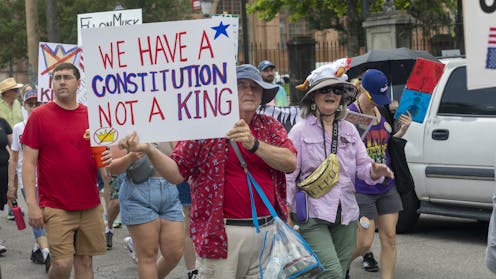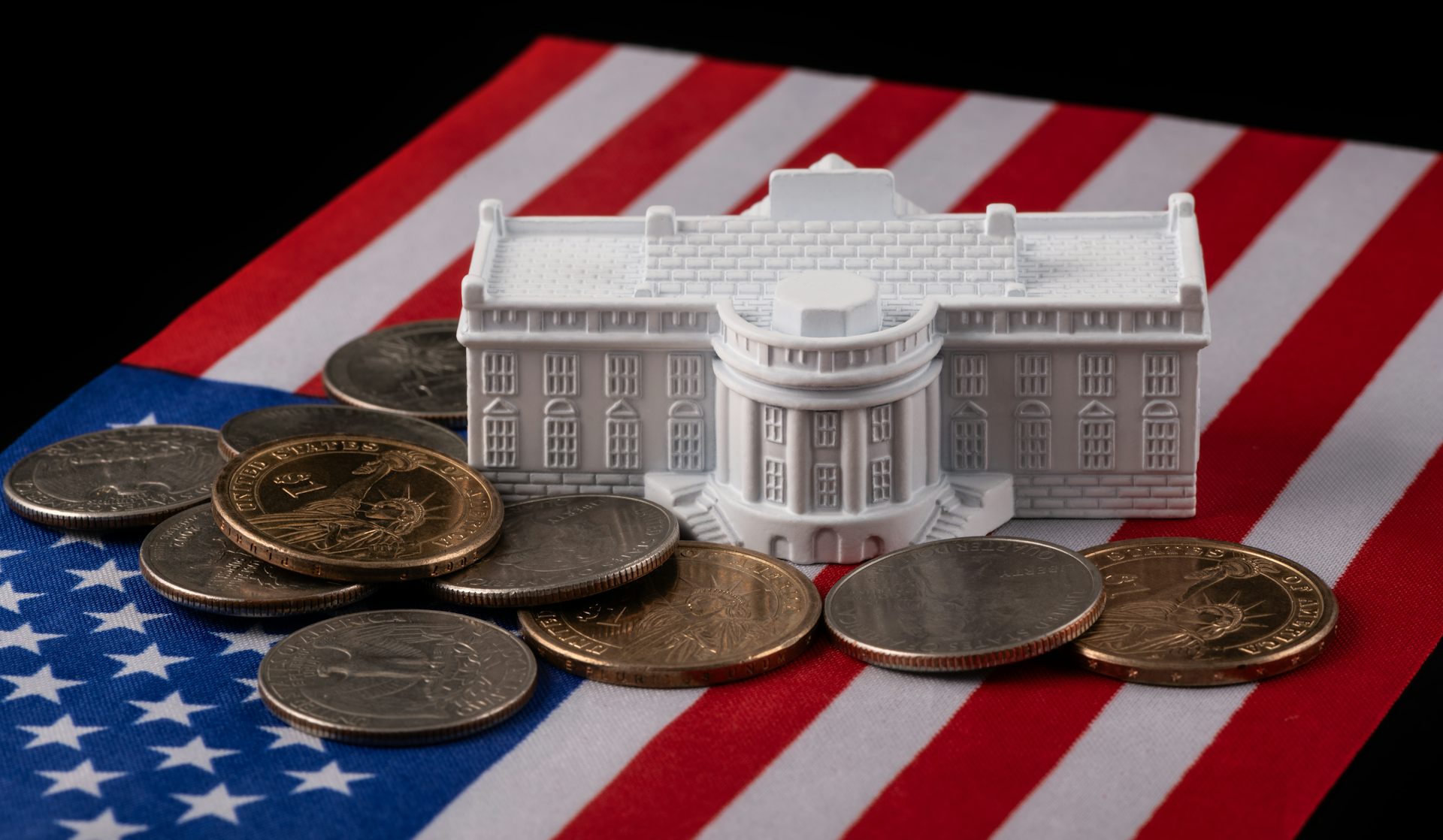Millions rally against authoritarianism, while the White House portrays protests as threats – a poli
Protests can serve two opposing purposes. They can represent a mass movement in favor of democracy – and simultaneously serve a nascent dictator in their efforts to undermine democracy.

At the end of a week when President Donald Trump sent Marines and the California National Guard to Los Angeles to quell protests, Americans across the country turned out in huge numbers to protest Trump’s attempts to expand his power. In rallies on June 14, 2025, organized under the banner “No Kings,” millions of protesters decried Trump’s immigration roundups, cuts to government programs and what many described as his growing authoritarianism.
The protests were largely peaceful, with relatively few incidents of violence.
Protests and the interactions between protesters and government authorities have a long history in the United States. From the Boston Tea Party to the Civil Rights movement, LBGTQ Stonewall uprising, the Tea Party movement and Black Lives Matter, public protest has been a crucial aspect of efforts to advance or protect the rights of citizens.
But protests can also have other effects.
In the last few months, large numbers of anti-Trump protesters have come out in the streets across the U.S., on occasions like the April 5 Hands Off protests against safety net budget cuts and government downsizing. Many of those protesters assert they are protecting American democracy.
The Trump administration has decried these protesters and the concept of protest more generally, with the president recently calling protesters “troublemakers, agitators, insurrectionists.” A few days before the June 14 military parade in Washington, President Donald Trump said of potential protesters: “this is people that hate our country, but they will be met with very heavy force.”
Trump’s current reaction is reminiscent of his harsh condemnation of the Black Lives Matter protests in the summer of 2020. In 2022, former Secretary of Defense Mark Esper said that Trump had asked about shooting protesters participating in demonstrations after the 2020 shooting of George Floyd.
As co-director of the Crowd Counting Consortium, which compiles information on each day’s protests in the U.S., I understand that protests sometimes can advance the goals of the protest movement. They also can shape the goals and behavior of federal or state governments and their leaders.
Opportunity for expressing or suppressing democracy
Protests are an expression of democracy, bolstered by the right to free speech and “the right of the people peaceably to assemble” in the First Amendment of the U.S. Constitution.
At the same time, clamping down on protests is one way to rebut challenges to government policies and power.
For a president intent on the further centralization of executive power, or even establishing a dictatorship, protest suppression provides multiple opportunities and pitfalls.
Widespread, well-attended demonstrations can represent a mass movement in favor of democracy or other issues as well as serve as an opportunity to expand participation even further. Large events often lead to significant press coverage and plenty of social media posting. The protests may heighten protesters’ emotional connection to the movement and increase fundraising and membership numbers of sponsoring organizations.
Though it is not an ironclad law, research shows that when at least 3.5% of the total population is involved in a demonstration, protesters usually prevail over their governments. That included the Chilean movement in the 1980s that toppled longtime dictator Augusto Pinochet. Chileans used not only massive demonstrations but also a wide array of creative tactics like a coordinated slowdown of driving and walking, neighbors banging pots outside homes simultaneously, and singing together.
Protests are rarely only about protesting. Organizers usually seek to involve participants in many other activities, whether that is contacting their elected officials, writing letters to the editor, registering to vote or running a food drive to help vulnerable populations.
In this way of thinking, participation in a major street protest like No Kings is a gateway into deeper activism.
Risks and opportunities
Of course, protest leaders cannot control everyone in or adjacent to the movement.
Other protesters with a different agenda, or agitators of any sort, can insert themselves into a movement and use confrontational tactics like violence against property or law enforcement.
In one prominent example from Los Angeles, someone set several self-driving cars on fire. Other Los Angeles examples included some protesters’ throwing things like water bottles at officers or engaging in vandalism. Police officers also use coercive measures such as firing chemical irritants and pepper balls at protesters.
When leaders want to concentrate executive power and establish an autocracy, where they rule with absolute power, protests against those moves could lead to a mass rejection of the leader’s plans. That is what national protest groups like 50501 and Indivisible are hoping for and why they aimed to turn out millions of people at the No Kings protests on June 14.
But while the Trump administration faces risks from protests, it also may see opportunities.
Misrepresenting and quashing dissent
Protests can serve as a justification for a nascent autocrat to further undermine democratic practices and institutions.
Take the recent demonstrations in Los Angeles protesting the Trump administration’s immigration raids conducted by Immigration and Customs Enforcement, or ICE.
Autocrats seek to politicize independent institutions like the armed forces. The Los Angeles protests offered the opportunity for that. Trump sent troops from the California National Guard and Marines to Los Angeles to contain the protests. That domestic deployment of the military is rare but not unheard of in U.S. history.
And the deployment was ordered against the backdrop of the president’s partisan June 10 speech at a U.S. military base in North Carolina. The military personnel in attendance cheered and applauded many of Trump’s political statements. Both the speech and audience reactions to it appeared to violate the U.S. military norm of nonpartisanship.
This deployment of military personnel in a U.S. city also dovetails with the expansion of executive power characteristic of autocratic leaders. It is rare that presidents call up the National Guard; the Guard is traditionally under the control of the state governor.
Yet the White House disregarded that Los Angeles’ mayor and California’s governor both objected to the deployment.
The state sued the Trump administration over the deployment. The initial court decision sided with California officials, declaring the federal government action “illegal.” The Trump administration has appealed.
Autocrats seek to spread disinformation. In the case of the Los Angeles protests, the Trump administration’s narrative depicted a chaotic, gang-infested city with violence everywhere. Reports on the ground refuted those characterizations. The protests, mostly peaceful, were confined to a small part of the city, about “a 10-block area.”
More generally, a strong executive leader and their supporters often want to quash dissent. In the Los Angeles example, doing that has ranged from the military deployment itself to targeting journalists covering the story to arresting and charging prominent opponents like SEIU President David Huerta or shoving and handcuffing U.S. Sen. Alex Padilla, a California Democrat.
The contrast on June 14 was striking. In Washington, D.C., Trump reviewed a parade of troops, tanks and planes, leaning into a display of American military power.
At the same time, from rainy Bethlehem, Pennsylvania, to sweltering Yuma, Arizona, millions of protesters embraced their First Amendment rights to oppose the president. It perfectly illustrated the dynamic feeding deep political division today: the executive concentrating power while a sizable segment of the people resist.
Jeremy Pressman does not work for, consult, own shares in or receive funding from any company or organization that would benefit from this article, and has disclosed no relevant affiliations beyond their academic appointment.
Read These Next
The Bible says little about Jesus’ childhood – but that didn’t stop medieval Christians from enjoyin
Legends about Jesus’ early years that circulated in medieval Europe often drew on apocryphal texts.
Whether Netflix or Paramount buys Warner Bros., entertainment oligopolies are back – bigger and mor
Hollywood has seen this movie before.
How a niche Catholic approach to infertility treatment became a new talking point for MAHA conservat
Mainstream medical organizations have criticized ‘restorative reproductive medicine,’ but some Catholics…






